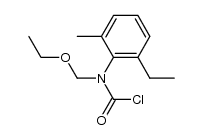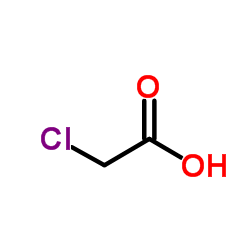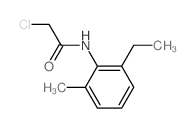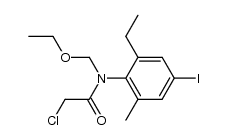34256-82-1
| 中文名 | 乙草胺 |
|---|---|
| 英文名 | acetochlor |
| 中文别名 |
2-氯-2’-甲基-6’-乙基-N-(乙氧甲基)乙酰替苯胺
消草安 禾耐斯 2'-乙基-6'-甲基-N-(乙氧甲基)-2-氯代乙酰替苯胺 2-氯-2'-甲基-6'-乙基-N-(乙氧甲基)乙酰替苯胺,禾耐斯 2'-乙基-6'甲基-N-(乙氧甲基)-2-氯代乙酰替苯胺 刈草胺 乙基乙草安 |
| 英文别名 |
Harness
2-chloro-N-ethoxymethyl-2'-methyl-6'-ethyl-acetanilide MFCD00143534 Nevirex top hand 2-chloro-N-ethoxymethyl-6’-ethylacet-o-toluidide EINECS 251-899-3 Acetochlore Azetochlor Erunit 2-chloro-N-(ethoxymethyl)-N-(2-ethyl-6-methylphenyl)acetamide Acenit |
| 密度 | 1.1±0.1 g/cm3 |
|---|---|
| 沸点 | 391.5±42.0 °C at 760 mmHg |
| 熔点 | <0ºC |
| 分子式 | C14H20ClNO2 |
| 分子量 | 269.767 |
| 闪点 | 190.5±27.9 °C |
| 精确质量 | 269.118256 |
| PSA | 29.54000 |
| LogP | 2.92 |
| 外观性状 | 油性液体在室温中,淡琥珀色至紫罗兰色颜色芳香气味 |
| 蒸汽压 | 0.0±0.9 mmHg at 25°C |
| 折射率 | 1.539 |
| 储存条件 | 保持贮藏器密封、储存在阴凉、干燥的地方,确保工作间有良好的通风或排气装置 |
| 稳定性 | 常温常压下稳定 |
| 计算化学 | 1.疏水参数计算参考值(XlogP):无 2.氢键供体数量:0 3.氢键受体数量:2 4.可旋转化学键数量:6 5.互变异构体数量:无 6.拓扑分子极性表面积29.5 7.重原子数量:18 8.表面电荷:0 9.复杂度:260 10.同位素原子数量:0 11.确定原子立构中心数量:0 12.不确定原子立构中心数量:0 13.确定化学键立构中心数量:0 14.不确定化学键立构中心数量:0 15.共价键单元数量:1 |
| 更多 | 1. 性状:浅棕色液体 2. 密度(g/mL,20℃):1.1 3. 相对蒸汽密度(g/mL,空气=1):未确定 4. 熔点(ºC):>0 5. 沸点(ºC,常压):>200 6. 沸点(ºC,KPa):未确定 7. 折射率:n20/D 1.5272 8. 闪点(ºC):>68 9. 比旋光度(º):未确定 10. 自燃点或引燃温度(ºC):未确定 11. 蒸气压(Pa,20ºC):133.3 12. 饱和蒸气压(KPa,20ºC):未确定 13. 燃烧热(KJ/mol):未确定 14. 临界温度(ºC):未确定 15. 临界压力(KPa):未确定 16. 油水(辛醇/水)分配系数的对数值:3.03 17. 爆炸上限(%,V/V):未确定 18. 爆炸下限(%,V/V):未确定 19. 溶解性:水:25ºC,223mg/L |
|
Section1. IDENTIFICATION OF THE SUBSTANCE/MIXTURE Product identifiers Product name: Acetochlor CAS-No.: 34256-82-1 Relevant identified uses of the substance or mixture and uses advised against Identified uses: Laboratory chemicals, Manufacture of substances Section2. HAZARDS IDENTIFICATION Classification of the substance or mixture Classification according to Regulation (EC) No 1272/2008 [EU-GHS/CLP] Acute toxicity, Inhalation (Category 4) Specific target organ toxicity - single exposure (Category 3) Skin irritation (Category 2) Skin sensitization (Category 1) Acute aquatic toxicity (Category 1) Chronic aquatic toxicity (Category 1) Classification according to EU Directives 67/548/EEC or 1999/45/EC Harmful by inhalation. Irritating to respiratory system and skin. May cause sensitization by skin contact. Very toxic to aquatic organisms, may cause long-term adverse effects in the aquatic environment. Label elements Labelling according Regulation (EC) No 1272/2008 [CLP] Pictogram Signal wordWarning Hazard statement(s) H315Causes skin irritation. H317May cause an allergic skin reaction. H332Harmful if inhaled. H335May cause respiratory irritation. H410Very toxic to aquatic life with long lasting effects. Precautionary statement(s) P261Avoid breathing vapours. P273Avoid release to the environment. P280Wear protective gloves. P501Dispose of contents/ container to an approved waste disposal plant. Supplemental Hazardnone Statements According to European Directive 67/548/EEC as amended. Hazard symbol(s) R-phrase(s) R20Harmful by inhalation. R37/38Irritating to respiratory system and skin. R43May cause sensitization by skin contact. R50/53Very toxic to aquatic organisms, may cause long-term adverse effects in the aquatic environment. S-phrase(s) S36/37Wear suitable protective clothing and gloves. S60This material and its container must be disposed of as hazardous waste. S61Avoid release to the environment. Refer to special instructions/ Safety data sheets. Other hazards - none Section3. COMPOSITION/INFORMATION ON INGREDIENTS Substances Formula: C14H20ClNO2 Molecular Weight: 269,77 g/mol ComponentConcentration Acetochlor CAS-No.34256-82-1- EC-No.251-899-3 Index-No.616-037-00-6 Section4. FIRST AID MEASURES Description of first aid measures General advice Consult a physician. Show this safety data sheet to the doctor in attendance. If inhaled If breathed in, move person into fresh air. If not breathing, give artificial respiration. Consult a physician. In case of skin contact Wash off with soap and plenty of water. Consult a physician. In case of eye contact Rinse thoroughly with plenty of water for at least 15 minutes and consult a physician. If swallowed Never give anything by mouth to an unconscious person. Rinse mouth with water. Consult a physician. Most important symptoms and effects, both acute and delayed To the best of our knowledge, the chemical, physical, and toxicological properties have not been thoroughly investigated. Indication of any immediate medical attention and special treatment needed no data available Section5. FIREFIGHTING MEASURES Extinguishing media Suitable extinguishing media Use water spray, alcohol-resistant foam, dry chemical or carbon dioxide. Special hazards arising from the substance or mixture Carbon oxides, nitrogen oxides (NOx), Hydrogen chloride gas Carbon oxides, nitrogen oxides (NOx), Hydrogen chloride gas Advice for firefighters Wear self contained breathing apparatus for fire fighting if necessary. Further information no data available Section6. ACCIDENTAL RELEASE MEASURES Personal precautions, protective equipment and emergency procedures Use personal protective equipment. Avoid breathing vapors, mist or gas. Ensure adequate ventilation. Evacuate personnel to safe areas. Environmental precautions Prevent further leakage or spillage if safe to do so. Do not let product enter drains. Discharge into the environment must be avoided. Methods and materials for containment and cleaning up Soak up with inert absorbent material and dispose of as hazardous waste. Keep in suitable, closed containers for disposal. Reference to other sections For disposal see section 13. Section7. HANDLING AND STORAGE Precautions for safe handling Avoid contact with skin and eyes. Avoid inhalation of vapour or mist. Conditions for safe storage, including any incompatibilities Store in cool place. Keep container tightly closed in a dry and well-ventilated place. Containers which are opened must be carefully resealed and kept upright to prevent leakage. Specific end uses no data available Section8. EXPOSURE CONTROLS/PERSONAL PROTECTION Control parameters Components with workplace control parameters Exposure controls Appropriate engineering controls Handle in accordance with good industrial hygiene and safety practice. Wash hands before breaks and at the end of workday. Personal protective equipment Eye/face protection Face shield and safety glasses Use equipment for eye protection tested and approved under appropriate government standards such as NIOSH (US) or EN 166(EU). Skin protection Handle with gloves. Gloves must be inspected prior to use. Use proper glove removal technique (without touching glove's outer surface) to avoid skin contact with this product. Dispose of contaminated gloves after use in accordance with applicable laws and good laboratory practices. Wash and dry hands. The selected protective gloves have to satisfy the specifications of EU Directive 89/686/EEC and the standard EN 374 derived from it. Body Protection Complete suit protecting against chemicals, The type of protective equipment must be selected according to the concentration and amount of the dangerous substance at the specific workplace. Respiratory protection Where risk assessment shows air-purifying respirators are appropriate use a full-face respirator with multi-purpose combination (US) or type ABEK (EN 14387) respirator cartridges as a backup to engineering controls. If the respirator is the sole means of protection, use a full-face supplied air respirator. Use respirators and components tested and approved under appropriate government standards such as NIOSH (US) or CEN (EU). Section9. PHYSICAL AND CHEMICAL PROPERTIES Information on basic physical and chemical properties a) AppearanceForm: liquid Colour: light yellow b) Odourno data available c) Odour Thresholdno data available d) pHno data available e) Melting point/freezingno data available point f) Initial boiling point and 134 °C at 0,5 hPa boiling range g) Flash pointno data available h) Evaporation rateno data available i) Flammability (solid, gas) no data available j) Upper/lowerno data available flammability or explosive limits k) Vapour pressureno data available l) Vapour densityno data available m) Relative density1,135 g/cm3 n) Water solubility0,2 g/l at 20 °C o) Partition coefficient: n- log Pow: 2,719 octanol/water p) Autoignitionno data available temperature q) Decompositionno data available temperature r) Viscosityno data available s) Explosive propertiesno data available t) Oxidizing propertiesno data available Other safety information no data available Section10. STABILITY AND REACTIVITY Reactivity no data available Chemical stability no data available Possibility of hazardous reactions no data available Conditions to avoid no data available Incompatible materials Strong oxidizing agents Hazardous decomposition products Other decomposition products - no data available Section11. TOXICOLOGICAL INFORMATION Information on toxicological effects Acute toxicity LD50 Oral - rat - 763 mg/kg LD50 Dermal - rabbit - 4.166 mg/kg Skin corrosion/irritation Serious eye damage/eye irritation Eyes - rabbit - Mild eye irritation - Draize Test Respiratory or skin sensitization May cause sensitization by skin contact. Germ cell mutagenicity Genotoxicity in vitro - Human - lymphocyte Sister chromatid exchange Carcinogenicity IARC:No component of this product present at levels greater than or equal to 0.1% is identified as probable, possible or confirmed human carcinogen by IARC. Reproductive toxicity Developmental Toxicity - rat - Oral Effects on Embryo or Fetus: Fetotoxicity (except death, e.g., stunted fetus). Specific target organ toxicity - single exposure May cause respiratory irritation. Specific target organ toxicity - repeated exposure no data available Aspiration hazard no data available Potential health effects InhalationHarmful if inhaled. Causes respiratory tract irritation. IngestionHarmful if swallowed. SkinMay be harmful if absorbed through skin. Causes skin irritation. EyesCauses eye irritation. Signs and Symptoms of Exposure To the best of our knowledge, the chemical, physical, and toxicological properties have not been thoroughly investigated. Additional Information RTECS: AB5457000 Section12. ECOLOGICAL INFORMATION Toxicity Toxicity to fishLC50 - Oncorhynchus mykiss (rainbow trout) - 0,38 mg/l - 96,0 h Toxicity to daphnia and EC50 - Daphnia magna (Water flea) - 7,2 mg/l - 48 h other aquatic invertebrates Persistence and degradability no data available Bioaccumulative potential no data available Mobility in soil no data available Results of PBT and vPvB assessment no data available Other adverse effects Very toxic to aquatic life. no data available Section13. DISPOSAL CONSIDERATIONS Waste treatment methods Product Offer surplus and non-recyclable solutions to a licensed disposal company. Contaminated packaging Dispose of as unused product. Section14. TRANSPORT INFORMATION UN number ADR/RID: 3082IMDG: 3082IATA: 3082 UN proper shipping name ADR/RID: ENVIRONMENTALLY HAZARDOUS SUBSTANCE, LIQUID, N.O.S. (Acetochlor) IMDG: ENVIRONMENTALLY HAZARDOUS SUBSTANCE, LIQUID, N.O.S. (Acetochlor) IATA:Environmentally hazardous substance, liquid, n.o.s. (Acetochlor) Transport hazard class(es) ADR/RID: 9IMDG: 9IATA: 9 Packaging group ADR/RID: IIIIMDG: IIIIATA: III Environmental hazards ADR/RID: yesIMDG Marine pollutant: yesIATA: yes Special precautions for user Further information EHS-Mark required (ADR 2.2.9.1.10, IMDG code 2.10.3) for single packagings and combination packagings containing inner packagings with Dangerous Goods > 5L for liquids or > 5kg for solids. Section15. REGULATORY INFORMATION This safety datasheet complies with the requirements of Regulation (EC) No. 1907/2006. Safety, health and environmental regulations/legislation specific for the substance or mixture no data available Chemical Safety Assessment no data available Section16. OTHER INFORMATION Further information Copyright 2012 Co. LLC. License granted to make unlimited paper copies for internal use only. The above information is believed to be correct but does not purport to be all inclusive and shall be used only as a guide. The information in this document is based on the present state of our knowledge and is applicable to the product with regard to appropriate safety precautions. It does not represent any guarantee of the properties of the product. Corporation and its Affiliates shall not be held liable for any damage resulting from handling or from contact with the above product. See and/or the reverse side of invoice or packing slip for additional terms and conditions of sale. |
|
毒理学数据: 1、 皮肤、眼睛刺激毒性:兔子皮肤Draize标准实验:500mg/24H 2、 急性毒性:大鼠经口LD50:763mg/kg 大鼠腹腔LD50:1200mg/kg 小鼠经口LD50:1550mg/kg 兔子经口LD50:600mg/kg 兔子皮肤LDLo:1260mg/kg 3、 其他多剂量毒性:大鼠经口TDLo:229mg/kg/42D-I CHEMICAL IDENTIFICATION
HEALTH HAZARD DATAACUTE TOXICITY DATA
|
| 符号 |


GHS07, GHS09 |
|---|---|
| 信号词 | Warning |
| 危害声明 | H315-H317-H332-H335-H410 |
| 警示性声明 | P261-P273-P280-P501 |
| 个人防护装备 | Eyeshields;Faceshields;full-face respirator (US);Gloves;multi-purpose combination respirator cartridge (US);type ABEK (EN14387) respirator filter |
| 危害码 (欧洲) | Xn:Harmful |
| 风险声明 (欧洲) | R20;R37/38;R43;R50/53 |
| 安全声明 (欧洲) | S2-S36/37-S60-S61 |
| 危险品运输编码 | UN3082 9/PG 3 |
| RTECS号 | AB5457000 |
| 海关编码 | 3808931100 |
|
~79% 
34256-82-1 |
| 文献:Eszakmagyarorszagi Vegyimuvek Patent: US3941783 A1, 1976 ; |
|
~% 
34256-82-1 |
| 文献:Synthesis, , # 11 p. 942 - 944 |
|
~% 
34256-82-1 |
| 文献:Latli, Bachir; Casida, John E. Journal of Labelled Compounds and Radiopharmaceuticals, 1995 , vol. 36, # 2 p. 147 - 156 |
| 上游产品 5 | |
|---|---|
| 下游产品 0 | |
| 海关编码 | 2924299038 |
|---|---|
| 中文概述 | 2924299038 甜菜安、特丁草胺、乙氧苯草胺等〔包括甜菜宁、戊菌隆、酰草隆、乙草胺、乙霉威〕。监管条件:S(进出口农药登记证明)。增值税率:17.0%。退税率:9.0%。最低关税:6.5%。普通关税:30.0% |
| 申报要素 | 品名, 成分含量, 用途, 包装 |
| 监管条件 | S.进出口农药登记证明 |
| Summary | 2924299038 2-chloro-n-(ethoxymethyl)-n-(2-ethyl-6-methylphenyl)acetamide。supervision conditions:s(import or export registration certificate for pesticides)。VAT:17.0%。tax rebate rate:9.0%。MFN tarrif:6.5%。general tariff:30.0% |




